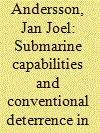| Srl | Item |
| 1 |
ID:
075362


|
|
|
|
|
| Publication |
London, Routledge, 2007.
|
| Description |
xvii, 193p.
|
| Standard Number |
0415393171
|
|
|
|
|
|
|
|
|
|
|
|
Copies: C:1/I:0,R:0,Q:0
Circulation
| Accession# | Call# | Current Location | Status | Policy | Location |
| 052585 | 355.03354/BIS 052585 | Main | On Shelf | General | |
|
|
|
|
| 2 |
ID:
138696


|
|
|
|
|
| Summary/Abstract |
The growing need to protect global shipping routes and the intensification of maritime territorial conflicts have led to a naval arms buildup around the world. Perhaps the most-cited example of this new focus on naval power is the increasing number of countries building or planning new aircraft carriers, but many analysts are more concerned about the proliferation of modern attack
submarines.
|
|
|
|
|
|
|
|
|
|
|
|
|
|
|
|
| 3 |
ID:
142977


|
|
|
|
|
| Summary/Abstract |
Submarines are often described as a weapon of choice for the weak to deter the strong. There are today a growing number of countries operating submarines in Southeast Asia, but just how capable are they? Unable to match the large multi-mission navies of countries such as China, India or Japan, many of the smaller economies in Southeast Asia have invested in conventional submarines to deter their neighbours. This article draws on deterrence theory to analyse the significance of submarine proliferation in Southeast Asia on the strategic balance in the region. It systematically examines submarine maintenance and training issues and concludes that the challenges involved in building up and maintaining a submarine force are far greater than is commonly understood or acknowledged. The evidence presented in this article suggests that few countries in the region currently have the capability and strategy to convincingly make the case that their submarine force by themselves could be an effective deterrent. Although the proliferation of submarines in Southeast Asia may suggests a changing strategic balance in the region, the findings of this study underscore the dangers of conflating acquisition of equipment with capabilities in practice.
|
|
|
|
|
|
|
|
|
|
|
|
|
|
|
|